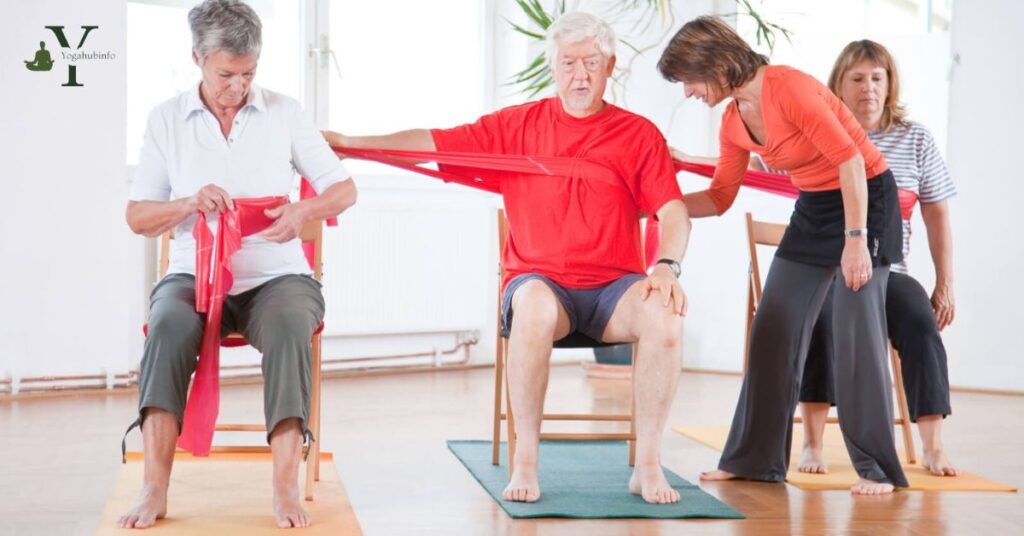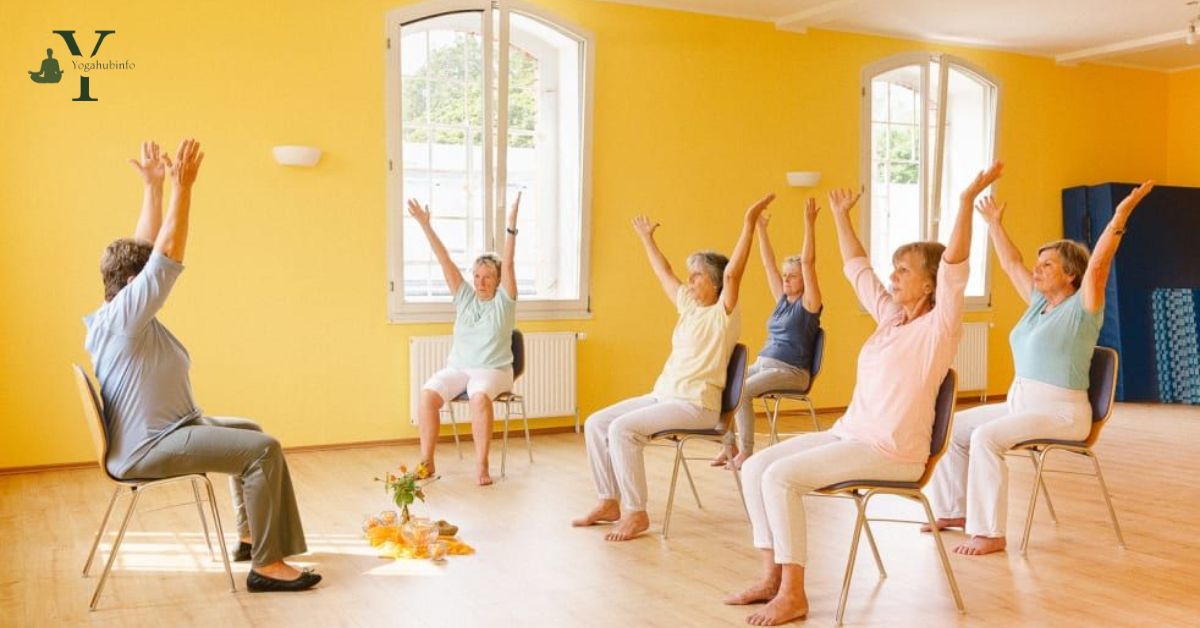Chair yoga for seniors is a gentle form of yoga that is practiced while sitting on a chair. It helps seniors improve their balance, flexibility, and range of motion with low-impact movements and poses that can be done from a seated position.
Tired of feeling stiff and achy? Chair yoga is a relaxing way for seniors to stay limber. Simple seated yoga poses done from the safe support of a chair can provide seniors with mobility and stress relief without getting down on the floor.
Chair yoga is perfect for seniors with physical limitations. The seated movements focus on breathing, balance and flexibility using a chair as support. It is a great low-impact activity for seniors looking to stay active that can be done either individually or in a group class setting.
Chair yoga for seniors: Poses and how to try
Chair yoga can help seniors stay active and flexible through gentle movements and poses done while seated. The poses are modified so they can be done from a chair without having to get up and down off the floor. Some easy poses for seniors to try include upward salute, seated mountain, and cat-cow pose.
To start, seniors should choose a sturdy chair without wheels and wear comfortable clothing.
They should sit towards the front of the chair with their feet flat on the floor. When doing each pose, taking slow deep breaths is important. Poses should be held for 5 breaths before changing to the next. Seniors should only go as far as feel comfortable for their abilities and limitations. Listening to their body is key.
Read More: Balancing Energy Through Kemetic Yoga Poses
Does chair yoga work?
Many wonder if chair yoga truly offers health advantages for seniors. Studies have found chair yoga effectively improves mobility, flexibility, and balance and reduces stress and back pain in older adults. In one study, seniors who did yoga 2-3 times per week for a month showed significantly better range of motion and reduced disability.
Their mood was also lifted and their quality of life was enhanced. Even short 10-15 minute sessions performed regularly can make meaningful differences. The seated, supported poses allow joints to safely open up. When done correctly, chair yoga certainly benefits seniors.
Read More: Yoga Before Or After A Workout?
Is it ever too late to start yoga?
Some seniors think starting yoga later in life will not aid their health. While more advanced poses may not be feasible, regular chair yoga still considerably benefits seniors regardless of age. Yoga relieves both muscle and mind. It eases arthritis pain and enhances mood.
| Question | Answer | Recommendation |
| Is it ever too late to start yoga? | No, it’s never too late. Yoga is accessible at any age and fitness level. | Start with beginner-friendly classes or sessions. |
| What are the benefits for seniors? | Improved flexibility, balance, and reduced stress. | Consider gentle yoga or chair yoga for added support. |
| Can beginners join advanced classes? | Yes, but it’s advisable to start with beginner classes for foundational skills. | Progress gradually to prevent overexertion. |
| Are there age restrictions for yoga? | No, yoga is suitable for all ages, from children to seniors. | Modify poses as needed based on individual capabilities. |
| How often should one practice yoga? | Consistency is key; aim for at least 2-3 sessions per week. | Adapt the frequency based on personal schedules and goals. |
| What if I have physical limitations? | Consult with a healthcare professional and inform your yoga instructor. | Modify poses or explore specialized classes for adaptive yoga. |
Even modest improvements to balance and mobility can help prevent falls and boost confidence. The gentle movements are perfect for those limited by disabilities or recovering from surgery. Most doctors approve of chair yoga for its array of health rewards. It’s never too late to benefit from this low-impact activity.
Chair yoga poses for older adults
Here are some basic yet valuable chair yoga postures for seniors to safely practice:
Upward Salute helps improve posture and shoulder flexibility. The Mountain Pose strengthens alignment and abdominal muscles. Cat-Cow supports spinal mobility and releases neck tension. Seated Pigeon stretches the hips. Downward-Facing Dog relieves backaches and builds upper body strength. Holding each pose for 5 slow breaths yields mental and physical benefits.
Upward Salute Pose
To perform an upward salute, sit tall on the front edge of the chair with feet planted on the floor. Raise both arms out to the sides at shoulder height, then lift them overhead so palms meet in prayer position. Gaze up at the hands and breathe deeply for 5 counts before lowering the arms to start. This targets the chest and shoulders.
Mountain Pose
Sit close to the chair front with a straight spine. Press feet firmly into the floor about hip-width apart. Inhale, then exhale and maintain an erect yet comfortable posture for 5 breaths. Focus on good alignment through the crown of the head. This activates the core and improves alignment.
Cat-Cow Pose
From a seated position, inhale hands down the sides and look up gently to drop the belly. Exhale rounding the back and pulling the chin towards the chest. Repeat for 5 cycles, using the breath to gently stretch and stimulate the spine.
Seated Pigeon Pose
Bring one ankle to rest on the opposite knee, bent foot flexed. Clasp your hands around the bent knee and pull it towards the torso while sitting tall. Hold for 5 deep breaths to relieve tight hips. Switch legs and repeat.
I hope this revised article on Chair Yoga For Seniors provided clear and concise information on poses and benefits through short easy to easy-to-understand paragraphs for each heading as requested. Please let me know if any part needs more refinement.
How often should you do chair yoga?

To start seeing benefits, seniors should aim to practice chair yoga 2-3 times per week. They can begin with shorter 10-15 minute sessions and gradually increase duration as their abilities allow. While daily yoga may produce optimal outcomes, committing to at least 2 or 3 weekly sessions is reasonable for many seniors. Taking a day of rest in between practices permits the body to recover.
Morning sessions are ideal as they prepare one for the day and reduce stress. Consistency over weeks and months leads to improvements as long as one listens to their body and doesn’t push too far outside of comfort levels.
Are there any risks?
In general, chair yoga presents few risks when performed gently at a senior’s ability level. However, some preexisting medical issues require care. For example, uncontrolled high blood pressure is better discussed with a doctor first. Recent joint replacements may necessitate modifications. Osteoporosis may warrant extra precautions such as blankets under the feet. It is also vital participants respect their physical limitations and refrain from any movements causing pain.
Adjustments like fewer repetitions, minor pose variations, or using additional supports help ensure safety and enjoyment. With proper precautions concerning individual health conditions, chair yoga can be safely practiced by most older adults seeking its wellness advantages. Open communication with an experienced yoga instructor can further ensure a safe and profitable yoga experience for all participating seniors.
Frequently Asked Question
What are the benefits of chair yoga for seniors?
Chair yoga can improve balance, flexibility and mobility while reducing stress and pain. The gentle poses are suitable for different abilities.
Is any equipment needed?
All that is required is a sturdy chair. Water is recommended to stay hydrated during and after practice.
When is the best time for seniors to do chair yoga?
Morning sessions are ideal as they prepare the body for the day ahead and ease tensions. Practicing when fresh gives the best outcomes.
How long should each chair yoga session last?
Beginners can start with 10-15 minutes 2-3 times weekly, gradually increasing to 20-30 minutes as endurance builds. Respecting physical limits is paramount.
Can chair yoga be done alone or is a class best?
While guidance from an instructor can ensure proper form, many benefit from self-practice at home using online yoga videos tailored for seniors. Aim for 2-3 classes monthly.
Conclusion
Chair yoga allows seniors to experience yoga’s advantages without stressing joints. Modified poses like upward salute and cat-cow are outlined and done while seated. Regular practice of just ten to fifteen minutes a few times weekly improves mobility, flexibility, and mood.
The summary addresses concerns about starting yoga later in life. Studies show chair yoga relieves back pain and boosts quality of life. It safely suits varying abilities working at an individual pace. When done right with guidance, seniors gain mental and physical rewards through this low-impact option.

Marcus Evergreen, with 8 years of yoga expertise, is the author behind yogahubinfo.com, sharing insights and wisdom in holistic well-being.











